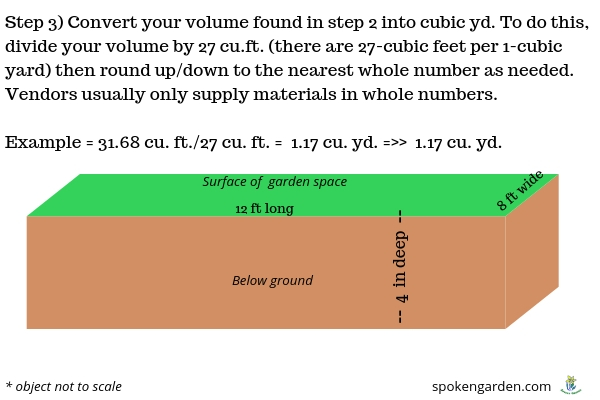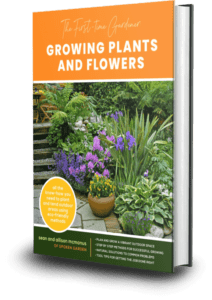Learn how to calculate the correct amount of soil, mulch, or rock material you need so you don’t order too much (or too little).
This spring you are most likely preparing to add some kind of landscape materials to your garden. If you are anything like us, we ordered multiple materials.
Before calling our local landscape supply store to place our order for delivery to our house (we needed a lot), we first estimated how much material we would need.
Believe it or not, gardeners often estimate incorrectly and end up with too much or too few of their intended landscape materials.
Plus, many people rely too heavily on random online calculators to do their math which are not always accurate.
We want to help you avoid that common mistake with some basic “garden” math so you can order as much material as you need.
In “How to Accurately Calculate Your Landscape Materials” – DIY Garden Minute Ep. 70 – we’ll teach you how to do the math for your landscaping project.
This episode is meant for any gardener who wants to learn how to calculate and order their materials accurately!
Landscape Materials
Every season we add new materials to our garden to help keep it healthy or improve it somehow.
How much material do you need to add? And, where should you buy it?
Most stores, like Home Depot or Lowe’s sell landscape materials in bags that are no more than 1/2 cu. ft each which is kinda small. Some offer larger quantities so you will definitely need to do your homework.
We always buy our supplies in bulk from local landscape supply companies so we can view them first and then have them delivered.
We are very picky that way and buying in bulk saves you money when buying multiple yards as the more yards you buy, the cheaper the material is per yard.
Examples of landscape materials you may need to order:
- Soil
- Mulch
- Rock or gravel
- Compost
- Sand
[convertkit form=1175393]
Performing Garden Math
Whether you need to buy mulch, soil, or compost, you need to learn a few basic calculations in order to be accurate.
Before you place your order, your goal is to calculate your total amount in cubic yards of the materials you will need.
Step 1: Find the Area
- Measure the square-feet (OR square-meters/centimeters) of the specific area where the new material will be used.
- Use the formula length x width for the intended space.
- This could be for one large area or for multiple small areas from around your garden all added together.
- Make any conversions of your units as needed (for example, from inches to feet).

Step 1) Find the area
Step 2) Find the Volume
- First, convert your depth (which will be in inches) into feet. There are 12-inches per foot, so if you want, for example, 4-inches of material, then divide 4-inches by 12-inches to get your conversion whole number, which in this case would be 0.33.
- Then, multiply your area from step 1 by the depth or thickness you desire to find the total volume. Use your conversion whole number to do this.
- When you do this, you will be changing your square feet into cubic feet, so you can then perform Step 3, but read the last two bullet points below before moving on to Step 3.
- Round your amount up/down to the nearest whole number as needed.
- Vendors usually only supply materials in whole numbers.

Step 3) Convert to cubic yards
- Most materials, at least in the US, are sold by the cubic yard, so you need to convert your volume from step 2 from cubic feet into cubic yards.
- To do this, divide your volume by 27-cubic feet to get your cubic yards. There are 27-cubic feet in 1-cubic yard.

Landscape Calculation Videos
Below are a couple of videos that might also be useful when determining your calculations for garden materials.
Landscape Design Tools and Materials
After ordering your landscape materials, such as soil, mulch, or rock, you will need to move it which takes proper skill and the right tools.
In order to get started, you need a good pitchfork, rake, round shovel, a tarp, and probably a wheelbarrow.
The recommendations below are products and brands that we’ve used for years in various landscape projects both at our home and with clients.
We hope these recommendations will be helpful for you too.
 Round Shovel
Round Shovel
This tool is imperative for moving all kinds of material.
We prefer this one by Fiskars because of its long handle and strong design.
Hard Metal Rake
The perfect tool for spreading mulch, rock, or soil around your yard.
We use this rake almost every day!
Pitch Fork
You will need a good pitchfork to move material around, especially mulch material.
This one has been a big help in our yard.
Tarp
A sturdy tarp is a must-have for keeping unused material contained or for dragging material around.
In fact, there are so many times we were fortunate to have a good tarp around. We find ourselves using it all the time.
 Wheelbarrow
Wheelbarrow
With this True Temper wheelbarrow, you can haul up to 6 cu. ft. of material all around your yard!
We recently used this wheelbarrow non-stop for a big home project moving soil and crushed gravel around our yard.
Garden rake
This type of fan rake is invaluable for home landscape projects.
We use it all the time, and not just for raking leaves (although it is great for that too!)
Landscaping Material Conclusion
Now you have learned how to calculate your material needs like a pro.
No more relying on online calculators to determine your square yards, you can more accurately do it yourself.
Now we want to hear from you!
What type of garden material will you be ordering?
Let us know by leaving a quick comment below. Thanks!
That’s all for this DIY garden minute episode!
You can find other one-minute topics on our podcast page at spokengarden.com/podcast
On Instagram or Pinterest under @SpokenGarden (all one word) to follow or leave us a comment.
Find us on your favorite podcast platform and Alexa through MyPod or AnyPod!
References:
- “How to Calculate Cubic Feet and Cubic Yards” -DIY Network
- ‘”How to Calculate Landscape Rock” – SF Gate
And hey—before you head out—if you want to connect with us and subscribe to our newsletter go to Spoken Garden’s free resource page!
We have FREE garden content we are so excited to give to you, like cheat sheets, plant profile sheets, etc!
Thanks for Listening!!!
Share Your Thoughts:
- Leave a note in the comment section below.
- Leave comments/ suggestions at Seanandallison@eseospace.dev
- Share our show on Twitter, Facebook, or Pinterest.
To Help Out The Show:
- Leave a review on iTunes. Your ratings and reviews really help us out!
- Subscribe on iTunes or Spotify.

Click the graphic above to save “Calculating Garden Materials” to Pinterest for later!
*Spoken Garden is a participant in the Amazon Services LLC Associates Program, an affiliate advertising program designed to provide a means for sites to earn advertising fees by advertising and linking to Amazon.com.
Learn how to calculate the correct amount of soil, mulch, or rock material you need so you don’t order too much (or too little).
Subscribe on iTunes
Today’s Topic:
Garden Material Calculations
Learn how to accurately determine the amount of landscaping materials you might need for your yard or garden.
Downloads:
What You’ll Learn:
- Examples of garden materials that need to be calculated using this garden math.
- Specific calculations to determine the amount of sq. yds. you’ll need to order (with graphics).
- Useful tools and materials you’ll need for success.
Resources:
Some of the resources and products below may be affiliate links, meaning we might get paid a commission (at no extra cost to you) if you use that link to make a purchase.
- Square Foot Gardening, Defined – DIY Garden Minute Ep. 66
- Pine Needle Mulch Benefits – DIY Garden Minute Ep. 62
- Top 7 Reasons Mulching Your Garden is Beneficial
- Best Pruning Shears For Any Gardener!
- Understanding Basic Plant Growth – DIY Garden Minute Ep. 30
Other Gardening Products Related To This Podcast You Might Not Have:
- Best pruning shears
- Loppers
- Hand saw:
folding or fixed
- Blower
: hand-held or backpack, gas or electric
- Leaf Rake
: metal or plastic
- Hard Rake
: metal







